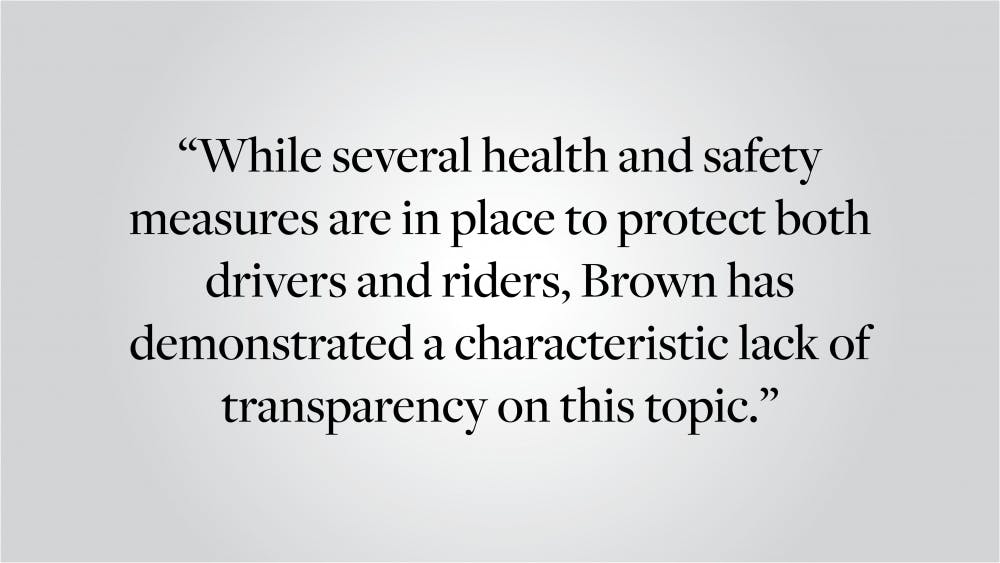With students living in Brown-leased hotels and apartments downtown, the Brown shuttle is an integral part of student access to campus. The Brown shuttles have expanded their routes this semester, but many riders still don’t know that shuttle drivers are not included in Brown’s routine COVID-19 testing program. While several health and safety measures are in place to protect both drivers and riders, Brown has demonstrated a characteristic lack of transparency on this topic. This is nothing new: The University has consistently misled the student population by refusing to proactively provide our community with information that impacts students and the community at large, particularly in this strange year.
Brown’s routine testing program has been the linchpin of its Healthy Brown initiative. It is likely the main reason why Brown has been able to keep case rates low, for the most part, even as the virus runs rampant in Providence’s surrounding neighborhoods. The thoroughness of Brown’s testing program has allowed me and many of my peers to remain comfortable with our decision to be in Providence this year.
Given the significant role that testing has played in the structure of our on-campus interactions, I have operated under the (false) assumption that virtually every individual who interacts with Brown students, through student services and Brown-sponsored programs, would have been incorporated into the testing program. This is especially true of shuttle drivers, who have become particularly relevant to campus life this semester since the expansion of Brown’s housing opportunities off of College Hill at places like the Omni Hotel, where many sophomores are currently housed.
Upon reaching out to the University about my concerns over this matter, I received a response from Elizabeth Gentry, assistant vice president of business and financial services, indicating that the “extensive health and safety measures in place on Brown’s shuttles,” which include drivers using a different door than students, plexiglass barriers and reduced passenger capacity, made testing drivers unnecessary. I was also informed that “shuttle rides are typically less than 15 minutes, windows remain open and data from our testing program has shown no evidence of COVID-19 spread related to shuttles.” Probing within my own pod, I only know of one contradiction to these statements: Windows don’t remain open on all rides.
Gentry explained to me that Brown regularly meets with First Transit — the company that provides the drivers, who are part-time contractors taking on a few shifts each week — “to review service expectations and safety protocols.” These meetings place special emphasis on making adjustments as needed to ensure the company is“providing the desired service levels with individual and community safety top of mind.” The precise nature of Brown’s negotiations with its contracted employees is surely a complicated business, and I remain sympathetic to those working hard to respect everyone’s labor and safety.
However, my concern lies with the lack of transparency in University decisions that affect its community. The slow circulation of this information over the past few weeks has alarmed the students and staff that I’ve spoken to, who assumed that shuttle drivers were a part of Brown’s routine COVID-19 testing program. Moreover, if drivers aren’t enrolled in Brown’s testing program, contact tracing could prove more difficult, especially as there is no system currently in place to track which students are riding which shuttles and at what times.
Since the beginning of the pandemic, students have been expressing concerns about their ability to make fully informed decisions about their academic careers, their health and the safety of their communities. Many students, myself included, feel that our agency to make informed decisions during this already strange and tumultuous academic year is repeatedly being sacrificed by University decision-making processes. We are informed about graduation plans, potential vaccination proceedings and now the status of contracted employees’ COVID-19 testing only after we have arrived on campus, paid tuition and paid for room and board (for those not living in off-campus residences). Brown is depending on its students to behave mindfully and conservatively in order to restrict the spread of COVID-19. In order to fully understand the risks that our behaviors entail, we need to be trusted to know the full picture of what exactly the University is and is not doing to protect its community.
Beth Pollard ’21 can be reached at beth_pollard@brown.edu. Please send responses to this opinion to letters@browndailyherald.com and op-eds to opinions@browndailyherald.com.

ADVERTISEMENT




